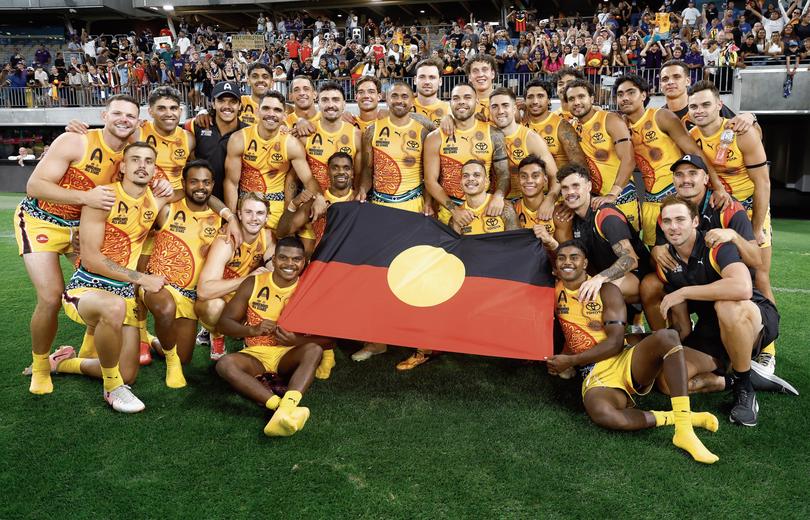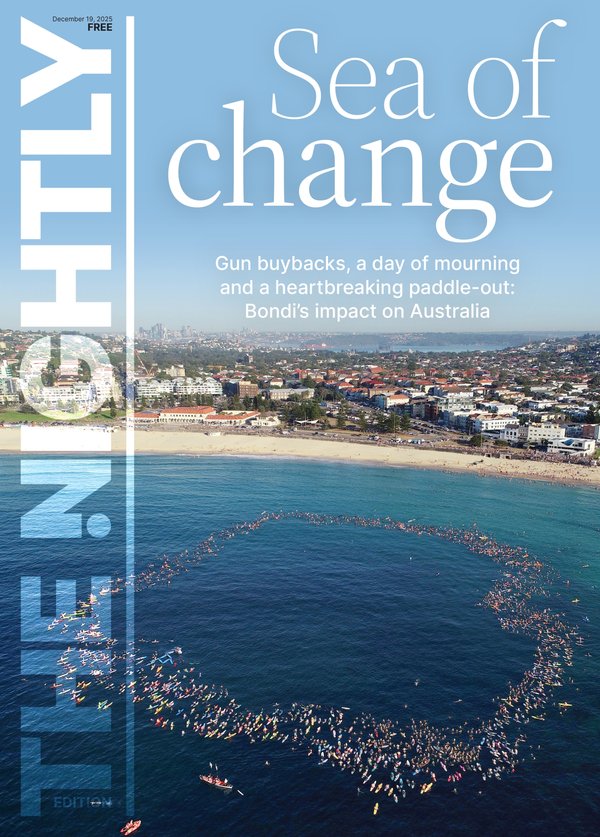JUSTIN LANGER: Indigenous All Stars Liam Ryan’s joy shows why the game is so vital for First Nations players
“My brother, it was f...ing awesome!”
The words were strong, the smile and body language stronger, as Liam Ryan succinctly described how he felt about last weekend’s Indigenous All Stars game. His smile told a thousand tales.
Frankly, I couldn’t have said it better myself. It really was awesome.
Sign up to The Nightly's newsletters.
Get the first look at the digital newspaper, curated daily stories and breaking headlines delivered to your inbox.
By continuing you agree to our Terms and Privacy Policy.Two nights before, West Coast’s famous high-flyer had said: “I’m a proud Yamatji man … I looked up to them all (previous All Stars and legends of the game), it means a lot to me and my family and the community.”
Introverted warrior Tim Kelly, sporting a black eye, walked past, nodded, smiled and said: “It was unreal to be a part of, so good, I loved it.”
Ryan and Kelly were at Mineral Resources Park on Monday morning watching the Eagles play Richmond in a practice match. Both men were still buzzing.
As was Tyrell Dewar, the First Nations kid who moved from the WA gold mining town of Kalgoorlie as a 13-year-old to attend Wesley College hoping to pursue his dreams and follow his heroes.
Dewar was on fire at West Coast’s training facility on Monday. A speedster, I couldn’t help but wonder if he had been inspired by watching his cultural brothers a few days before. Everything we witnessed suggested so. This was the best he had played in blue and gold. The coincidence seemed too stark, and I am not one for coincidence.
Heroes breed heroes. There is no greater form of stimulation for sustained success.
Michael “Sonny” Walters, the All Stars captain said after the game: “To go out and perform the way we did, it just goes to show you we have a bond that you really can’t break. And that’s sort of like Indigenous culture. We’re players from all over the country, and for us to come together in four days and play the way we did ... we built a bond for life.”
One of the highlights of the game was when Sonny ran to his Fremantle teammates at half time and gave them all a happy rev up. His vitality was palpable. He looked so happy and it’s no wonder young St Kilda star Nasiah Wanganeen-Milera glowed, saying: “It was unreal, one of the best days of my life”
All Stars head coach Xavier Clarke predicted: “This game is gonna have a big footprint on it, not only AFL football, but community footy and we’ll hopefully see some more young Indigenous boys playing the game in the future.”
Heroes breed heroes remember.
He also promised a gameplan to “let the boys play”. My gosh I am glad they did.
There were moments when we were left mesmerised and smiling. As a coach and parent, I couldn’t help wondering why we don’t let more of our players, “just play”.
The story of Indigenous players in the AFL is one of triumph, of cultural pride, and of an unmatched ability to transform a sport through their distinctive style of play.
Zoning, game plans and role play are important I guess, but I question if these would organically develop if we “just let them play”.
On Saturday, we witnessed Australian Rules football at its purest. The All Stars got the footy, ran hard and fast, tackled with passion and got the ball into their forward line with pace and precision. With only four days preparation this game style looked disciplined and smooth.
Sustainable? Who knows, who cares. All I know is that Saturday took me back to the game that so many of us love.
Through many First Nation’s players, past and present, I reflect with awe.
Lance “Buddy” Franklin’s eyes fixed on the Sherrin, his body coiled like a spring, ready to explode into action. Pure sporting magic.
Long before Buddy, Graham “Polly” Farmer revolutionised the game with his handball wizardry. In an era when the handball was merely a last resort, Polly transformed it into an offensive weapon.
His supernatural ability to palm the ball with pinpoint accuracy while being tackled, opened the game in ways that still influence modern football.
The Indigenous champion didn’t just play the game, he reimagined its possibilities. We now drive down his freeway. Statues, freeways and grandstands are usually named in honour of some type of magic makers.
The legacy of Stephen Michael, the South Fremantle champion who never played VFL despite countless offers, remains one of football’s most captivating stories. His dominance in the WAFL was absolute – a blend of raw power and grace that saw him win the Sandover Medal twice.
Those of us who saw him play speak of a player whose abilities seemed to defy the laws of physics; a talent so rare it comes along once in a generation. My grandparents and I watched him every weekend when I was a kid, I would count the days leading up to each game.
My hero may never have had a freeway or statue named after him, but he was the first selfie I ever asked for. To this day, it is still one of my happiest moments.

When the Krakouer brothers, Jim and Phil, burst onto the scene in the early 1980s, they brought with them a style of play that left spectators breathless. Their near-telepathic understanding of each other’s movements and their ability to create space where none existed added a new chapter to Indigenous excellence in football.
The “Krakouer Magic” became synonymous with a brand of football that was both highly effective and breathtakingly beautiful.
Having watched indigenous players of all ages, shapes and sizes play barefoot in the red dirt of the Pilbarra, it never surprised me when Benny Vigona or Bobby Hill soared like an Elon Musk rocket over the shoulders of one of their opponents.
Chris Lewis, Basil Campbell, David Wirrpanda offered similar brilliance and beauty. Lewis’s skills, Basil’s cannonball spirit and Wirra’s torpedo punts from fullback.
Eddie Betts in his prime, dancing along the boundary line, is more than just a footballer. He’s a storyteller writing tales with his feet, his hands, his entire being. Those impossible goals from the pocket weren’t just shots at goal, they were a testament to the extraordinary gifts his people bring to the game.
Dual Brownlow Medalllst Adam Goodes moved with the fluidity of a dancer and the strategic mind of a general. At times cruelly ostracised, the wisdom of generations must have been a part of him being crowned as the Australian of the Year in 2014.
The Rioli dynasty – from Maurice Senior through to Cyril and Daniel – embodies this heritage of excellence. Their trademark sidesteps, that seemingly supernatural ability to see plays unfold before they happen, speaks to an understanding of movement and space that runs deep in their blood. When Cyril would gather the ball in traffic, time seemed to slow down around him, as if the game itself was paying respect to his artistry.
Today, we see this legacy continued in players like Shai Bolton, whose aerial prowess and ground-level brilliance remind us that Indigenous players continue to revolutionize how the game is played. Their contributions bring an element of joy, of creativity, of pure athletic poetry that enriches the sport immeasurably.
Hawthorn favourite, Chance Bateman, who now works at the West Coast Eagles said in an interview: “Whenever you talk about connection to culture it’s usually through dance or language or song, so the opportunity for these young boys to get involved in it connects them straight into their culture that’s been around tens of thousands of years.”
On the sporting field these joys become so evident, especially when they are playing together.
The story of Indigenous players in the AFL is one of triumph, of cultural pride, and of an unmatched ability to transform a sport through their distinctive style of play. They remind us that football at its best is more than just a game – it’s an art form.
But sadly, we are in danger of losing this magic. In 2024, there were 71 AFL players who identified as Aboriginal and/or Torres Strait Islander. This is a decrease from 87 in 2020. Only three First Nations players were drafted in this last draft.
While the AFL has expressed concerns about the decline in Indigenous players in the league and called for new ideas to improve Indigenous engagement, everyone tells me more needs to be done.
The annual Sir Doug Nicholls Round, which celebrates Indigenous culture and history, is a wonderful event, as was the All Stars game, but resources at the grass roots levels, community and state leagues, must be increased and are imperative.
Footy clubs need to create environments where young Indigenous players feel a part of the family and racism must continue to be stamped out with steel-fisted authority.
Everyone can talk of the problems, that’s easy, but collective solutions must be found. Without these we will lose a very special part of the AFL.
My friend and Vice-President of the Fremantle Dockers, Colleen Hayward, said to me during the week: “Oh man, the All Stars was wonderful. It brought people together and celebrated what we love most of about the game.”
It sure did. It was wonderful, it was awesome, and it was a timely reminder that we have some work to do to ensure the magic never goes away.
